 |
Except for Nikon and the Italian industrial design firm of Giugiaro Design, Italy, which was headed by the master designer, Mr. Giorgetto Giugiaro. No one knows exactly when the Nikon F5 project began. The Italian design master also shared his genius on the core design of the Nikon F3 (1980) and the Nikon F4 (1988). Who knew what the F's would look like ? They could have been boring.. as shown by the early prototypes. Anyway the Nikon F3 was the first to carry the very eye-catching Nikon Red near the hand grip. |
|
|
Nikon
F3 |
Nikon
F3 |
|
|
Nikon
F4 |
Nikon
F4 |
|
The alternate F4 prototype (1988) shown at the bottom right was more interesting. Seemingly it bears the signature of Mr. Giorgetto because the eventual Nikon F4 that rolled out from the assembly line strongly resemble his designs. Nikon has published a picture of a F5's prototype in mockup model in their Technical Guide (Published: 08.1996 where the above image was acquired from). Compared with the standard production unit, many operational features and the basic form in the proposed design were adopted on the actual F5. This could be the final, accepted version among all the Prototypes. The camera shown was probably a clay/wood unit because the worn paint shows the material underneath.
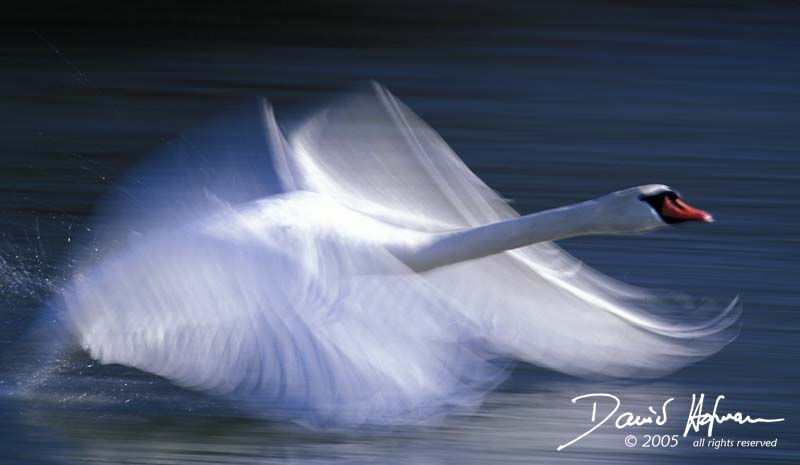 |
. |
The Swan Series by |
|
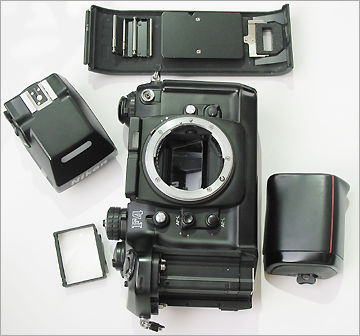 |
The question raised in my mind was, who actually decided to combine the power pack as an integrated unit with the camera ? Nikon ? the Designer ? The "forward-thinking" idea has also indirectly resulted in seeing omission of a segment in the unique feature found in all single-digit Nikon F models - a total Modular Design. a simple concept that all previous professional class Nikon F bodies were based on. Gone is the luxury of permitting photographer to determine how to configure or setup his camera for any particular type of photographic assignment. For example, to a reporter, obviously you don't need to bring a bag-full of gear just to cover a quick news event. In the case of off-duty personal photography, he may never have any choice and just have to live with the fact of traveling with a 1.2kg babe on the road. Assuming his favorite lens is an AF-S Nikkor 80-200mm f/2.8, that can be another 1.3kg... Ooops, the 1.2kg mentioned earlier was a bare body without batteries. |
So, it is another typical
story of assumption versus real life applications. The possible basis for such conclusion
was understandable. Any modern SLR consumes a tremendous amount of power. The days
of using two tiny button cells which may last for about a year is long gone. This
was made possible partly due to a combination of many things, such as some of the
operations were still mechanical. Even in the case of an entirely AUTO SLR camera
(such as immensely popular Canon A-1, Minolta XDs, Olympus OM2n etc.) and may still be able
to deliver similar performance in their respective power management for top performance
results. With the arrival of autofocus - things became very different indeed. The
constant rotation of the lens searching for pinpoint focus, minimal assistance of
mechanical parts, the enormous volume of data essential for critical metering &
exposure calculations has turned an autofocus camera instantly into a incredible
power-hungry tool. So, one of the many challenges for camera designers is how to
strike a balance between power efficiency and operational functionality of a camera.
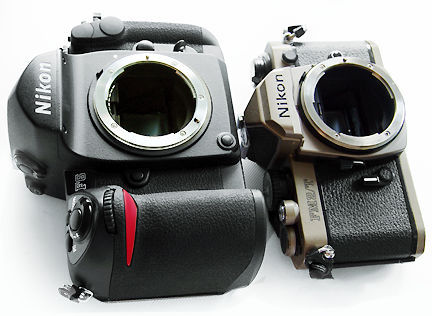 |
OFF TOPIC: The Nikon F6 has reverted to the old ways again by letting photographers determine their personal setup combination of the camera for assignments. It is not entirely a compact SLR, as seen in a quick side by side comparison with the classic Nikon FM2n/T. A little treat for owners of old Nikkor's, the MATRIX metering works ! But Nikon decided the interchangeable viewfinder is not a viable feature anymore... Why the back & forth decisions with just a basic configuration of a flagship camera model ? Strange huh ? but it is happening at Nikon. But I think the Nikon F6 should sell well in numbers again because of the matrix-enabling with old the Nikkor's as well as without a integrated power pack which has contributed in a cheaper entry. Well, expectation of a possible hybrid combination (film and digital) Nikon F6 - which supposedly will even be more exciting, as it should bear a strong product characteristic's as well as functionality in modern day photography as a worthy F5 successor. It was not presented during this debut. If it doesn't appear in the near future, Nikon will go back to the driver seat comfortably. A position that they have enjoyed for so long in the professional users market. |
With its sales targeting the professional photographer who generally create high volumes of images, naturally power becomes one critical issue to be addressed. As there is no backup mechanical lever(s) to trip for exposure once its power is depleted. The prevailing battery technology during late '80 was still confined between Alkaline & Nickel Cadmium (NiCd) rechargeables. These battery types were popularly used for AF cameras during early '90 but the formula to use 2 X CR123 Lithium also started to gain popularity in numbers. One of the changes during this period was introduction of Multi-Power Vertical Grip design as an accessory to house various battery alternatives. This emerged for SLRs such as Nikon F90X offered in the form of the Nikon MB-10 that enabled the usage of multi battery-types. It is also a great tool for vertical format shooting. The F5 provides an alternative power source in using a Nickel Metal Hydride ("Ni-MH") battery in the form of a one piece power pack (MN-30 with Charger, MH-30). The use of Mi-MH permits the F5 to reach peak performance in its maximum burst rate for both film advance as well as power film rewind with additional advantage of longer shooting at low temperature environment (but 8 x Lithium offers overall best performance when operating at normal temperatures).
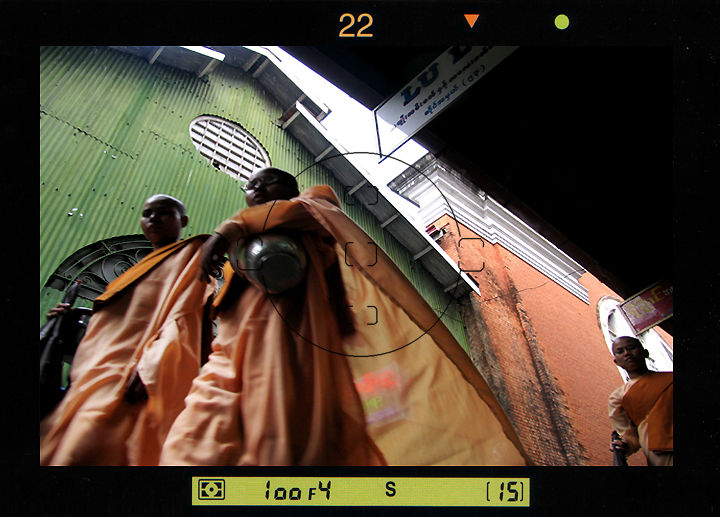 |
These incredibly sensitive to strangers lady Buddhist monks who practice strict disciplinary codes of living where they are much ignored by the society looked for donors at the famous Scott Plaza, Yangoon, Burma (now names as Myanmar). Picture was a grabbed shot with camera laid on the floor while wait for them to pass by.. |
|---|
The main point of discussion here is, the decision making guys probably convinced themselves that power is an inseparable component to a high drain modern SLR and that they should incorporate the power supply as an integral unit of the camera. This has mainly contributed to manufacturing of a camera that is both large and somewhat cumbersome. This also adds cost to the package and has made Nikon F5 less appealing for consideration. Nikon could have realized this via the sales figures accumulated over the entire generation of the F5. The "patch" for this highly unpopular decision was reflected in the current Nikon F6's reversion back to the old ways by separating the power source and offering it as an add on option. WHY the sudden change of heart? Mass market appeal of course ! Such a fine photographic tool should be enjoyed by all. The serious amateurs may also have a second thought and opt for a scaled-down version in the subsequent Nikon F100 which presents a far superior mobility factor in comparison to the F5.
 |
|
Next I keep wondering why Nikon adopted the business strategy of forcing customer's to buy their new lenses by incorporating the non-compatible lens mounting ring that restricts full scale usage of certain older Nikkor lenses with the F5. Backward compatibility has always been a strong factor for consideration of a possible upgrade. I did purchase some of the new AF-D Nikkor's simply to patch a few missing links on focal length and new lens-type. But NOT because of the extended features made available due to the AF-D/F5 combination. To expect me to sell my older Nikkor to upgrade with newer ones for the Xtra benefit on metering & exposure control is totally irrelevant to my decision making. Next the introduction of the aperture ring-less G-series Nikkor is even more frustrating than earlier mentioned.
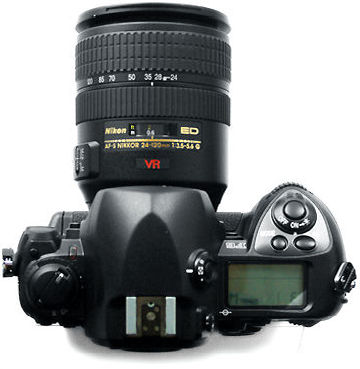 |
Come on, HOW MUCH can you actually save on an already weakly-made aperture ring in a Nikkor lense ? Millions of MF/AF Nikon have been sold thus far, eventually one of those users may want to buy a new lense for his Nikon, only to realize there is no such lens available to meet the specification of his camera. He most likely may end up in buying a third party label such as Sigma, Tokina or a Tamron .. or even possibly via Ebay bidding. But NOT on the zero-IQ assumption one will definitely sell his camera, buy a new one in order to use a new lens. ! We do understand virtually all new Nikon bodies are all using F5's pioneered* Command Dial method to control apertures and shutter speeds but such a short sighted commercial idea can put off any potential income for the Company within its huge pool of users. I wonder if the savings can be converted and dispersed back to the consumers, wishful thinking but not likely. |
It has taken Nikon 8 years to present this superb camera to the market. During this time it appears that Nikon has lost commanding market shares (pro users) to Canon because they did not react in a timely fashion. Personally, I think they could have shortened its debut by two years. BUT one of the main problems was mainly centered on the Nikkor lens line. As I pointed out repeatedly in other sections of this site. It takes an AF-D Nikkor to optimize its full potential but options and numbers in the hands of users for the new breed were not ready. It is like the chicken & egg story all over again. As a user would you like the idea of upgrading your ENTIRE existing batch of Nikkor just to take advantage of a new metering system? Conventional wisdom will say a BIG ... "NO". As time goes by, you probably may say "YES". But the Nikon F5 was the only capable solution to assist those who require such a high level of performance. The Pros were the main target again to lead the consumption of the "new" breed of AF-D Nikkor lenses.
The earlier Nikon F90 (X) who stood alone in holding the Nikon flag high to counter aggression of its main business rivalries has laid a good solid foundation. Thus enabling the spread of AF-D Nikkor to the mass market. It was also the first to spearhead the demonstration of various enhancement advantages of the improved Nikon proprietary 3D Matrix metering. So the numbers began growing by every passing day. This was only happening and was more confined to the serious amateur market rather than the pros. If one can recall, the BIG Nikkor tele available from 1992 to 1994 were the AF-1 series of super-tele lenses (iincidentally, AF-I are genetically a D-lense in nature), so, it also means the variety of lens types were quite limited during that stage. So what is the point of rushing in its debut while the figures and lens varieties were not ready yet ?
| Previous | NEXT | 1/3 Other Issues + a little personal notes
| Back | Main Index Page - Nikon F5 Professional SLR camera
The Camera - Background, Issues
& Summary
Basic
Features | Focusing | Metering Systems | Exposure Control | Reliability Issues | Nikkor lens Compatibility
Prisms/Finders - Index page
- 2 parts
Film Backs: Index
Page - 1 parts
Focusing Screens - Index
Page - 1 part
Flash System - Index
Page
- 3 parts
System Accessories: | Power Sources | Cases | Remote
Control | Miscellaneous
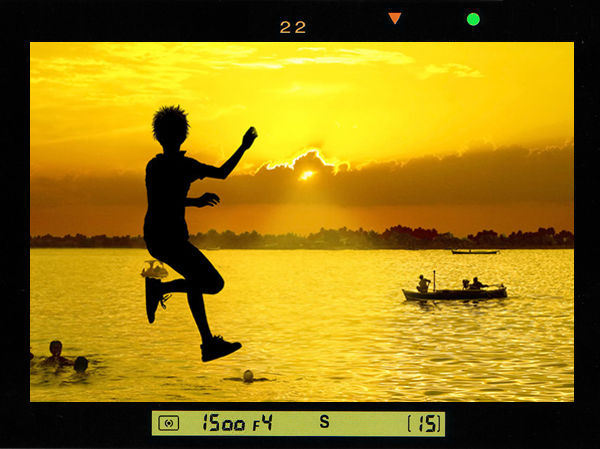 |
To some, Life is a moment of JOY... Sulawasi, Indonesia |
Macro
Photography
- Related info on Micro-Nikkor lenses
Technical Specification for Nikon F5
Main
Reference Map
/ Nomenclature
Resource Centre:
Instruction Manuals
Nikon
F5 Camera Body
- 18
parts
MF-28
Multi-Function Back
HTML - 8
parts
PC
Links - Photo Secretary
- 2
parts
AF-TTL Speedlights:
SB-28 / SB28DX | SB29(s) info | SB30 | SB50DX | SB80DX | SB600 info | SB800
Variants: F5 50th Anniversary Model | Nikon/Kodak DCS-620 | DCS-720 Digital Still SLR camera | NASA-modified Nikon F5
| Back | Index Page of Digital
Nikon SLR cameras
|
Back | to
Pictorial History of Nikon
SLR / rangefinders / Nikonos / digital cameras.
![]()
| Nikon F | Nikon F2 | Nikon F3 | Nikon F4 | Nikon F5 | Nikon F6 | Nikkormat / Nikomat | Nikon FM | Nikon FE/ FA | Nikon EM/FG/FG20 | Nikon Digital SLRs | Nikon - Other models |
The Eyes of Nikon:-
Nikon Auto Focus Nikkor lenses:- Main
Index Page
Nikon Manual Focus Nikkor lenses:- Fisheye-Nikkor Lenses - Circular | Full Frame |
Ultrawides Lenses - 13mm15mm18mm20mm | Wideangle Lenses - 24mm28mm35mm | Standard Lenses - 45mm 50mm 58mm | Telephoto
Lenses - 85mm105mm135mm180mm & 200mm | Super-Telephoto Lenses - 300mm 400mm 500mm 600mm 800mm 1200mm |
 Index Page |
Special
Application lenses: Micro-Nikkor Lenses - 50mm~55mm -60mm 85mm -105mm 200mm Micro-Zoom 70-180mm Perspective Control (PC) - 28mm 35mm PC-Micro 85mm Dedicated Lenses for Nikon F3AF: AF 80mm f/2.8 | AF 200mm f/3.5 EDIF Depth of Field Control (DC): 105mm 135mm Medical Nikkor: 120mm 200mm Reflex-Nikkor Lenses - 500mm 1000mm 2000mm Others: Noct Nikkor | OP-Nikkor | UV Nikkor 55mm 105mm | Focusing Units | Bellows-Nikkor 105mm 135mm Nikon Series E Lenses: 28mm35mm50mm100mm135mm | E-Series Zoom lenses: 36~72mm75~150mm70~210mm |
MF Zoom-Nikkor Lenses: 25~50mm | 28~45mm | 28~50mm | 28~85mm | 35~70mm | 36~72mm E | 35~85mm | 35~105mm | 35~135mm | 35~200mm | 43~86mm | 50~135mm | 50~300mm | 70~210mm E | 75~150mm E | 80~200mm | 85~250mm | 100~300mm | 180~600mm | 200~400mm | 200~600mm | 360~1200mm | 1200~1700mm
Tele-Converters: TC-1 | TC-2 | TC-200 | TC-201 | TC-300 | TC-301 | TC-14 | TC-14A | TC-14B | TC-14C | TC-14E | TC-16 | TC-16A | TC-20E
Recommended links to understand more technical details
related to the Nikkor F-mount and production Serial Number:
http://rick_oleson.tripod.com/index-153.html by: my
friend, Rick Oleson
http://www.zi.ku.dk/personal/lhhansen/photo/fmount.htm by: Hansen,
Lars Holst
http://www.mir.com.my/rb/photography/hardwares/nikonfmount/lens2.htm
http://www.photosynthesis.co.nz/nikon/serialno.html
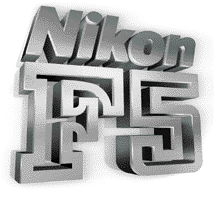 |
| Message Board | for Nikon F5 Series SLR model(s) | |
About this photographic site.
HOME - Photography in Malaysia |
![]()
A resource dedicated to my kids:- Alvin Foo & Esther Foo- one day,
BOTH might need to use all these information for his/her Nikon F5A camera.
Volunteered Maintainer(s) for the Nikon F5 Message Board: Tony Davies-Patrick, UK; Rick Oleson, US; Koh Kho King, Malaysia.
Credit: Mr. Chuck Hester, US for his text re-editing skill for this site; Our staff, HowKiat® who created the 3D-Nikon F5 logo. Mr. Lew Chee Wai of YL camera for lending his F5 for me to take some shots appeared in this site. All those nice folks who have contributed their images, in particular Mr. Mike Long, Edwin leong, Palmi Einarsson, Sergio Pessolano, Fred Kamphues, Harry Eggens, Curtis Forrester, Nick (Natures Moments), Sandra Bartocha; fellow countrymen, Vincent Thian, Koh Kho King, Philip Chong, CY Leow etc. and contributions from a few nice folks from Photo Malaysia Forum. Disclaimers & acknowledgments: Certain content and images appeared in this site were either scanned from official marketing leaflets, brochures published by Nikon and/or contribution from surfers who claimed originality of their own work for public publishing in this website, where majority of the extracted information are used basing on educational merits. The creator of this site will not be responsible for any discrepancies that may arise from any possible dispute except rectifying them after verification from respective source. Neither Nikon or its associates has granted any permission(s) in using their public information nor has any interest in the creation of this site. "Nikon", "Nikkormat", "Nippon Kokagu KK" "Silent Wave", "Focus Tracking Lock-on", "Nikkor" & other applicable technical/business terms are registered trade name(s) of Nikon Corporation Inc., Japan. Site made with an Apple G5 IMac.



